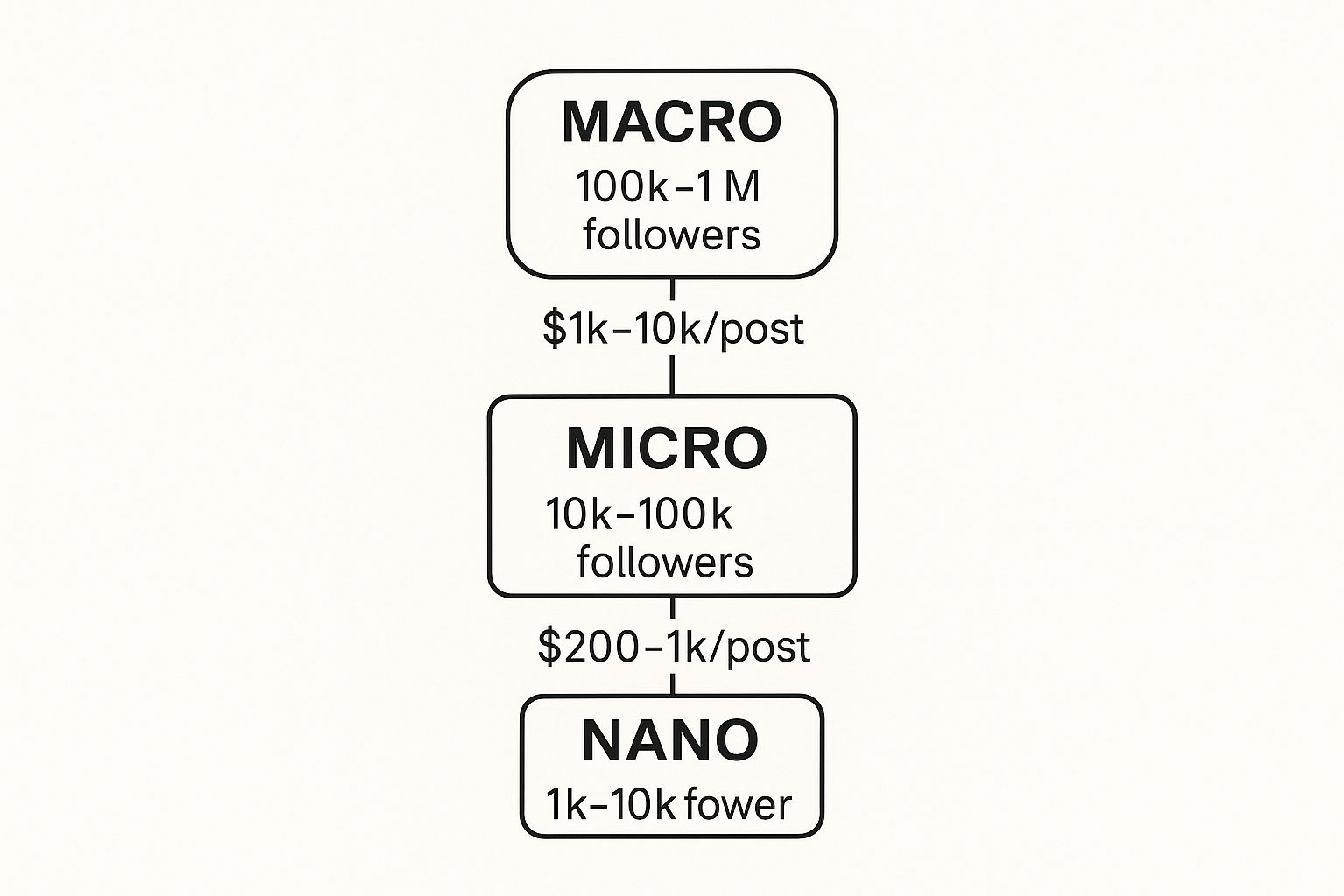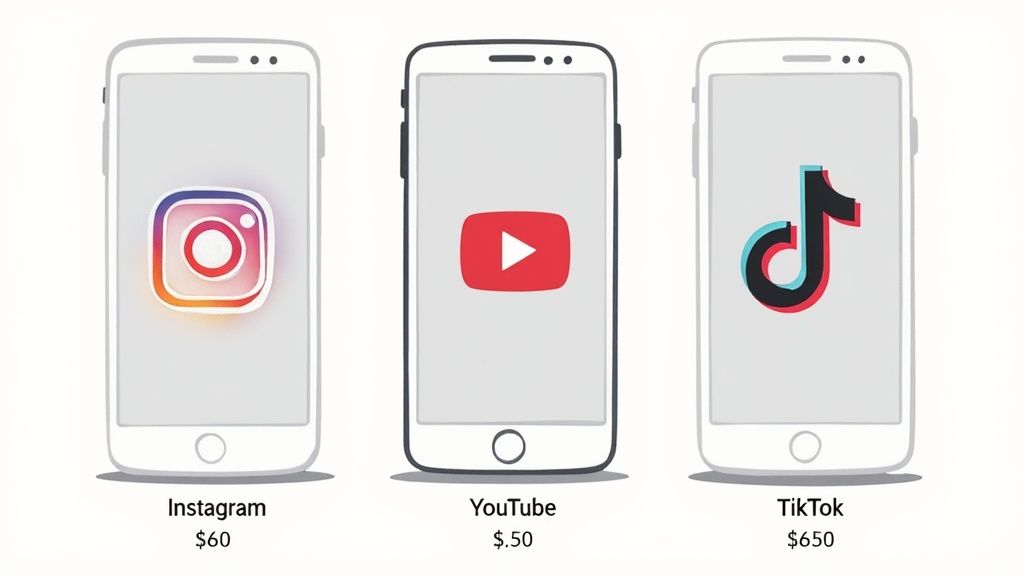
Influencer Marketing Rates: What You'll Actually Pay
Published
The Real Story Behind Influencer Marketing Costs

To make sense of influencer marketing rates, it's important to see them as more than just a price tag on a post. Influencer marketing is no longer a side hustle; it's a fully developed marketing channel with its own complex pricing world. The old days of just sending free products and hoping for a shout-out are disappearing for professional creators. Now, rates are set by a mix of art and science.
This change is driven by massive growth. The global influencer marketing industry has more than tripled in size since 2020. Forecasts predict the market could reach about $33 billion by 2025, and U.S. spending is projected to hit a new high of $7.1 billion in 2024. This huge increase in spending shows a major shift in how brands think about their budgets, moving from traditional ads to more authentic, people-driven promotions. You can see more details about this growth in the influencer marketing spending forecasts on Statista.
From Side Hustle to Sophisticated Business
Think of a modern influencer not as a hobbyist, but as a small media company. They aren't just creating content—they're the creative director, on-screen talent, editor, and distribution platform all rolled into one. This is why their follower count alone doesn't explain their cost. When a brand pays an influencer, they're investing in that creator's entire production process and, more importantly, the trust they've built with a niche audience.
This business-first approach means what you pay is tied to the value they deliver. A great campaign isn't just an expense; it's an investment in genuine storytelling that can often perform better than standard advertising. To really understand the pricing, it helps to see the other side of the deal by learning about how much an influencer typically earns. Understanding their perspective clarifies why collaborations are priced the way they are and what work is involved. This knowledge is key to making a smart investment instead of a costly error.
Decoding Influencer Tiers: Where Your Money Goes
When you start exploring influencer marketing rates, you'll find that follower count is just one piece of the puzzle. Think of it like buying a car: the sticker price is just the start. You also consider fuel efficiency, reliability, and maintenance costs. In the same way, an influencer’s value isn't just their audience size, but the quality of their community and the engagement they command.
An influencer's value is often classified by the tier they belong to, which is primarily based on their follower count. Each tier offers unique benefits and comes with a different price tag.
From Nano to Mega: Understanding the Categories
Influencers are typically grouped into categories that help brands align their budget with specific campaign goals. These tiers range from creators with small, highly-engaged followings to those with massive, celebrity-level reach. It’s not always about finding the person with the most followers, but the one with the right followers for your brand.
- Nano-Influencers (1,000–10,000 followers): These are your community champions. They have smaller but fiercely loyal audiences who genuinely trust their opinions. Their high engagement and authentic voice make them ideal for brands wanting to build deep, credible connections.
- Micro-Influencers (10,000–100,000 followers): A step up in audience size, micro-influencers strike a great balance between reach and engagement. They often specialize in a specific niche, making them perfect for targeted campaigns that need to feel both authentic and impactful.
- Macro-Influencers (100,000–1 million followers): These are the well-known figures in their respective fields. With substantial reach, they excel at driving broad brand awareness. They often operate like professional content creators with streamlined processes for brand collaborations.
- Mega-Influencers (1M+ followers): This category includes celebrities and top-tier digital personalities. Their primary advantage is immense, broadcast-style reach, making them suitable for large-scale campaigns designed to generate significant buzz.
To give you a clearer picture of how these tiers translate to costs, here is a breakdown of average rates across popular platforms.
Influencer Rate Comparison by Tier and Platform
A comprehensive breakdown of pricing ranges across different influencer tiers for major social media platforms
| Influencer Tier | Follower Range | TikTok Rate | Instagram Rate | Engagement Rate |
|---|---|---|---|---|
| Nano | 1K-10K | $5 - $25 | $10 - $100 | 4.5% - 5.7% |
| Micro | 10K-100K | $25 - $125 | $100 - $500 | 1.5% - 2.5% |
| Macro | 100K-1M | $125 - $1,250 | $500 - $5,000 | 1.0% - 1.5% |
| Mega | 1M+ | $1,250+ | $5,000+ | 0.5% - 1.0% |
As the table shows, there's a significant jump in cost as you move up the tiers. However, notice how engagement rates tend to decrease as follower counts rise. This inverse relationship is a key reason why many brands are looking closely at smaller creators for more meaningful interactions.
The Shift Towards Smaller, More Engaged Creators
Interestingly, bigger doesn't automatically mean better results. A growing number of brands are discovering greater value in partnering with creators who have smaller audiences. In fact, one notable trend shows that brands prefer working with nano (44%) and micro-influencers (26%) over their larger counterparts. You can explore more data on brand preferences in influencer marketing on ClearVoice.
This shift is fueled by a desire for better cost-effectiveness and higher engagement. Smaller, tight-knit communities often produce more authentic and impactful interactions. This highlights a crucial insight for any brand: the quality of the connection often outweighs the quantity of followers.
This infographic helps visualize the typical pricing structure across the nano, micro, and macro tiers.

As the diagram illustrates, costs rise sharply with each tier, reinforcing why many brands are finding the return on investment from nano and micro-influencers so compelling.
Platform Economics: Where Your Budget Works Hardest

Each social media platform is its own distinct marketplace, complete with different audiences, content styles, and rules of engagement that directly influence influencer marketing rates. Assuming a creator’s price should be the same everywhere is like expecting a primetime TV ad to cost the same as a small newspaper placement. The environment itself shapes the value, and a smart marketer knows how to put their budget where it will have the most impact.
A major reason for these price differences is content production complexity. A polished YouTube video, for example, demands far more effort—scripting, filming, and detailed editing—than a quick Instagram Story or a spontaneous TikTok video. This is why YouTube creators consistently command the highest rates. Research indicates the average sponsored TikTok video costs around $2,700, whereas a similar campaign on YouTube could easily top $10,000, reflecting the greater investment in production time and resources.
Comparing Costs and Opportunities
The platform's main function and its audience also play a big role in pricing. Instagram, with its emphasis on high-quality visuals and lifestyle content, has a widely accepted starting rate of about $100 per 10,000 followers. To truly stretch your budget on platforms like Instagram, it helps to understand effective strategies for getting more views on Instagram Reels, which can directly boost the value an influencer delivers.
On the other hand, TikTok’s algorithm is known for its ability to make content go viral, regardless of a creator's follower count. This creates a unique value proposition where brands are essentially paying for a chance at massive, trend-driven reach, often at a lower starting cost than Instagram.
To help you visualize these differences, the table below breaks down how these platforms compare for a typical micro-influencer partnership.
Platform Pricing and Engagement Comparison
Side-by-side analysis of average costs and engagement rates across major social media platforms
| Platform | Average Cost per Post | Engagement Rate | Content Type | Best For |
|---|---|---|---|---|
| $100 - $500 | 1.5% - 2.5% | Polished Photos, Reels, Stories | Aesthetic-driven brands, lifestyle | |
| TikTok | $25 - $125 | 4.0% - 6.0% | Short-form, Trend-based Video | Driving virality, Gen Z audience |
| YouTube | $200 - $5,000 | 2.0% - 4.0% | Long-form, In-depth Video | Product reviews, educational content |
This comparison shows that a smaller budget on TikTok can potentially lead to higher engagement, while a larger investment on YouTube is suited for more detailed, lasting content.
Ultimately, picking the right platform isn't just about finding the cheapest option. It's about aligning your budget with your campaign goals. If your objective is in-depth product education and creating a long-term asset, the higher cost of a YouTube collaboration is easily justified. If you want to tap into a viral trend for quick brand awareness, TikTok provides a high-reward setting for a more modest initial investment.
The Hidden Rate Drivers Nobody Talks About
While follower counts and platform choice set the stage for influencer marketing rates, several behind-the-scenes factors have a massive impact on the final price. Think of these as the hidden variables in a negotiation. Understanding them is what separates a standard campaign from a professional one, often saving you significant budget while strengthening your creator partnerships.
One of the most significant yet overlooked factors is usage rights. When you pay for a post, you're typically just renting space on the influencer's feed. If you want to repurpose that content for your own website, paid ads, or email marketing, you'll need to negotiate broader usage rights. This is a separate value proposition and comes at a premium because the influencer is essentially licensing their creative work and likeness for your commercial use.
Exclusivity and Timing
Another critical rate driver is exclusivity. Asking an influencer not to work with your direct competitors for a specific period—say, 30 to 90 days—limits their earning potential. Naturally, they will charge more to compensate for this lost opportunity. The price of an exclusivity clause often depends on the length of the agreement and the breadth of the market you want them to avoid. A longer, more restrictive clause will command a higher fee.
Timing also plays a surprisingly large role. Just like holiday travel, influencer rates can see seasonal spikes. Demand for creators skyrockets during peak shopping seasons like Black Friday or the December holidays. A campaign launched in October could cost 25-50% less than the exact same campaign run in late November simply due to this increased demand. Smart brands plan their campaigns for off-peak seasons to get more value for their investment.
Content Complexity and Niche Premiums
Finally, consider the nuances of content complexity and audience niche. A simple selfie with a product is far less work than a multi-location, professionally shot video with complex editing. The more production effort required, the higher the cost.
Similarly, influencers in highly specialized or profitable niches—like finance, B2B software, or specialized medical fields—can charge a premium. Their audience is not only hard to reach but also holds immense value for specific brands. Beyond the metrics, understanding how influencers' performance indicators factor into pricing is essential. A great place to start is by learning the details of an Instagram engagement rate formula, as it provides a tangible measure of an audience's responsiveness, which directly influences a creator's value.
Negotiation Strategies That Actually Work
 A successful negotiation over influencer marketing rates feels less like a battle and more like building a partnership. The aim isn't to squeeze every last dollar from the budget but to find a sweet spot where both your brand and the creator feel the collaboration is fair and valuable. If you approach these discussions with a cooperative spirit, you're setting the stage for a great deal and even better results.
A successful negotiation over influencer marketing rates feels less like a battle and more like building a partnership. The aim isn't to squeeze every last dollar from the budget but to find a sweet spot where both your brand and the creator feel the collaboration is fair and valuable. If you approach these discussions with a cooperative spirit, you're setting the stage for a great deal and even better results.
The key to a smooth negotiation is preparation. Before you even think about hitting "send" on that outreach email, do your homework. Look at the influencer’s previous sponsored posts, not just their regular content, to get a real sense of how their audience responds to brand collaborations. Arrive at the conversation with a clear budget and a detailed creative brief outlining exactly what you expect. This level of professionalism shows you respect their craft and their business.
Structuring a Win-Win Deal
When you get to the numbers part of the conversation, think beyond just a flat fee. Many influencers are receptive to hybrid compensation models that provide value in different ways.
- Offer Affiliate Commission: Suggest a performance-based element. You could offer a lower base fee paired with a commission on every sale generated from their content. This approach gives the creator a direct stake in the campaign's success and aligns your goals perfectly.
- Provide High-Value Products: For micro-influencers or creators who are genuinely fans of your products, a generous product package can be a compelling part of the deal. This can significantly reduce your upfront cash spend.
- Bundle Deliverables for Better Rates: Instead of negotiating for one post at a time, propose a content package. For instance, ask for a bundle that includes one Instagram Reel, three Stories, and a link in their bio for a week. Bundling often brings the cost per piece of content down compared to buying them all separately.
Key Negotiation Points
Remember that almost everything is up for discussion. If an influencer's initial quote seems high, don't be afraid to ask for more details. A simple question like, "Could you walk me through how you arrived at this rate?" can open up a productive dialogue about the value they provide, which might include factors you hadn't considered.
On the flip side, be prepared to explain your own offer. You can reference your research on their engagement rates with similar sponsored campaigns to support your number. The goal is to ground the negotiation in performance data and mutual benefit, rather than just pulling prices out of thin air. This method not only helps protect your budget but also builds a strong foundation for a lasting partnership.
When Paying More Actually Costs Less
It might sound backward, but in influencer marketing, the cheapest option is frequently the most expensive one down the line. Experienced marketers know that paying premium **influencer marketing rates** for a high-quality creator can deliver a much better return than spreading the same budget across several low-cost, low-impact influencers.Think of it this way: you could hire one expert carpenter to build a sturdy house or five amateurs who leave you with a structure needing constant, expensive repairs. The first choice has a higher initial cost, but the long-term value and the avoidance of costly mistakes make it the smarter financial move. A premium influencer brings a level of professionalism, content quality, and audience trust that a "bargain" creator often can't match, which directly leads to better results.
The Real Cost of a "Cheap" Campaign
When you choose a less expensive influencer, you might save money upfront, but you often pay for it in other ways. These hidden costs can undermine your entire campaign.
- Wasted Spend on Unengaged Audiences: A low-cost influencer might have a large follower count, but if that audience is filled with bots or simply doesn't interact, your message disappears into the void. You end up paying for reach that doesn't truly exist.
- Poor Quality Content: Premium creators are professional content producers. A low-cost alternative might deliver amateurish content that harms your brand's image and forces you to spend more time on revisions or even reshoots.
- Missed Conversion Opportunities: The ultimate goal is almost always to drive action. A high-quality creator with a loyal following can generate significant sales or leads. A cheaper one might get a few likes but fail to convert, meaning your investment brings zero tangible return.
Calculating True Value Over Surface Metrics
To truly understand the cost, you must look past surface-level numbers like cost per post. The metric that really matters is Return on Investment (ROI). A campaign with a top-tier creator might cost $5,000 but generate $25,000 in sales, delivering a 400% ROI. On the other hand, five "cheap" campaigns at $500 each (for a total of $2,500) might only bring in $1,500 in sales, resulting in a net loss.
When you invest in a creator with proven engagement, strong brand alignment, and high-quality production skills, you're not just buying a post. You're investing in a powerful brand asset that builds trust and drives real business outcomes. This is the scenario where paying more actually costs you less.
Building Smart Budget Strategies for Long-Term Success
A static budget is a fragile one, especially in the fast-paced world of influencer marketing. For your campaigns to succeed over the long haul, your financial planning needs to be as dynamic as the market itself. This isn't about simply setting aside funds for a single campaign; it's about creating a flexible strategy that can adapt to new trends, creators, and platforms. Smart budgeting isn't about spending less—it's about spending smarter to maximize growth and stay competitive.
Technology is a major force shaping influencer marketing rates and strategies. The industry is expected to grow by a remarkable 35.63% between 2024 and 2025, a pace that leaves many traditional marketing channels behind. A significant part of this growth is fueled by AI, with 66.4% of marketers saying AI tools have improved their campaign results through better personalization and smoother operations. The takeaway is clear: forward-thinking budgets must include investments in technology that boosts performance. You can dive deeper into these trends by reading the full influencer marketing benchmark report.
Building a Flexible and Forward-Thinking Budget
So, how do you create a budget that is both resilient and ready for what's next? A great framework to start with is the 70-20-10 rule. It helps you balance reliable, proven methods with the need to explore and innovate.
- 70% for Proven Winners: This is the largest part of your budget. Allocate these funds to the creators, platforms, and content formats that have consistently delivered solid results for your brand. Think of this as your core investment, designed to generate a steady, predictable return.
- 20% for Emerging Opportunities: Dedicate this slice of the budget to testing new ground. This might involve partnering with a creator on a rising platform you haven't used before or trying out a new content style, like long-form video, with a creator you already trust.
- 10% for Bold Experiments: This is your "what if" fund. It’s for the high-risk, potentially high-reward ideas that could lead to your next big breakthrough. You might collaborate with an unconventional creator or test a completely new partnership model. This small allocation lets you innovate without putting your entire budget at risk.
Using this structure ensures your spending is efficient while you actively search for new ways to grow. By continuously testing, learning, and scaling what works, you can refine your approach and ensure your influencer marketing investments create lasting value.
Ready to find the talent that will drive your next successful campaign? Explore hundreds of roles and connect with top marketing professionals on Influencer Marketing Jobs today.